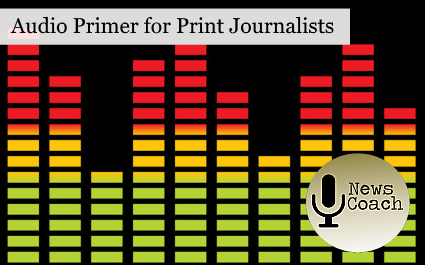Crossing over: Audio advice for print reporters

This is the second in a series, aimed primarily at print and radio
reporters who are asked to produce video reports. For multimedia
journalists, these skills are a must. And for video reporters, it's a
reminder of key elements that can make your stories stand out.
Read part one here.
We started with some of the basics of video reporting: Gathering
video, natural sound and soundbites. And we covered ledes and the sentence
structure of writing a video piece. Now we turn our attention to reading
what you've written, and adding a voice track to your story.
Perhaps you’re concerned about your voice. Or someone else is. Is it too high, too flat, too whiney, too nasal, too young-sounding, too weak? Is your dialect too distracting? Voice Options Do your very best to stop having angst over your voice. The more self conscious we are, the tighter we are, and the worse our voice will sound.
We know you by your byline and your publication. We trust your reporting. It’s time to hear your voice and perhaps meet you in a standup. You probably won’t sound like Barry White or Adele, but we want to hear from you just the same. We breathe all day and night without worrying about it, so don’t worry about it now. When we breathe in, our stomachs stick out. When we breathe out, our stomachs pull in. Try your best to push your speaking air out from your stomach, knowing the pump doesn’t stop until the last sound of the last word of each sentence wafts out fully and clearly. If you hear a weakness or a crackling at the ends of sentences, you’re ‘stopping the pump’ too soon! Even skinny people like me have loads of extra air in our lungs to draw from.
As long as you’re keeping your sentences simple, sending your voice out from your stomach and not from your neck, and you’re not trying to be a robot devoid of emotion, you should be okay. You have reactions in your head as a journalist. You’re not sharing them with us, but tapping into them as you speak should be enough to bring your story to life.
The most common foibles are sounding flat, dull, sing-songy or weak. I refer to this last liability as the ‘you just got out of the hospital’ voice. Here’s a common solution: Dive in with a full, healthy, hardy voice sent out from your stomach and don’t think about intentionally pausing. You’ll tell me this, you'll tell me that. You’ll speak in informative (I call them cognitive) chunks, and not purposefully ‘emphasize’ individual words. Each time you begin a new sentence, remember to send your voice out on an arc; picture it wafting out of my iphone, my computer, a speaker, and tickling me on the shoulder. Hey, I’m talking because this is something I really think you’d like to know about. Keep your voice rolling out. Your words and sentences are landing a good foot out in front of you. Use your hands and make faces if that’s you. We’re not seeing any of this, just listening.
You do have the option of putting print slates where your voice would be. The more powerful the story- the more appropriate this option becomes. But we’d love to hear from you directly.
Tracking
Don’t beat yourself up. I’d say 30 percent of my work addresses the voiceover conundrum. What’s odd is that I need to remind folks that they speak all day long. They don’t worry how they’ll say something, and they sound perfectly fine! Here’s my best overall advice, and thoughts about tracking a video piece:
Tracking is NOT about sounding like a ‘professional’ or even trying to be ‘conversational.' You can’t purposefully impose some silly stuff like shellac and glitter and dark clouds over your printed words to make us go ‘ooooh.’ The concept of ‘conversational’ should naturally evolve from the way each of us speaks. And, please add no purposeful pauses for drama. When we pause, and for how long, will take care of itself.
Go for the whole cognitive chunk of info. Tell me what’s going on. Speak on the flow of air from your stomach and let the implications and innuendos that strike you at the moment naturally ‘configure’ your voice! It’s much like reading a storybook to a child.
Try bringing yourself back to the moment of discovery as you covered your story. Tap into your marvel as you learned and discovered the information you believe is imperative to share. Please take strong note of this verb. It’s great having the opportunity to bring your story to life so that we can appreciate it as you did. Dive back into time and channel it. No false pomp or orchestrated delivery is needed; just you, personally recounting facts and details so that we can fully appreciate this news story that you’ve discovered or further dissected.
Sitting vs. standing? Whatever makes you most comfortable!
For those of you who must first swear that you won’t destroy yourselves overthinking (trust me- it’s my daily fight), I hesitantly provide you here with my pdf Unlock Your Potential. It’s in the public domain, from my 2012 Excellence in Journalism Workshop.
Joanne Stevens
News consultant Joanne Stevens has written extensively about broadcast writing, reporting and anchoring, including columns in the former print version of RTDNA's Communicator Magazine, and earlier versions of the RTDNA website. She has taught at Columbia and New York University and serves as a news award judge for the New York Press Club. She has returned to RTDNA.org to offer a new series of News Coach columns with tips, best practices and more. - Click on the RTDNA logo below to learn more.


